Who Is Affected by Improper Clinical Waste Disposal?

Improper clinical waste disposal doesn’t just create inconvenience. It creates risk. When an item ends up in the wrong bin or when processes are inconsistent, the consequences ripple through every stage of the waste journey – from the point of care to final treatment. Everyone in the waste journey deserves protection.
How can we avoid improper sharps and clinical waste disposal? It requires breaking down each step of the waste journey and examining the waste practices, not to place blame, but to raise awareness and support safer decisions at every stage.
TOPICS WE WILL COVER:
1 / Who Is Affected by Improper Clinical Waste Disposal?
2 / The Different Stages of the Waste Journey
3 / The Overfilled Sharps Container Scenario
4 / How Does Improper Waste Disposal Affect the Environment?
5 / Sharpsmart Provides Empowerment Through Systems and Support
Who Is Affected by Improper Clinical Waste Disposal?
Improper disposal of clinical waste can impact infection control and put many people at risk. When you dispose of a waste item, you’re never the last person to interact with it. Several others may handle, transport, or process that waste before it reaches its final destination. If disposal isn’t done correctly, every person downstream who comes into contact with that waste is at risk and could be exposed to harm.
Some of those who may be affected include:
- Healthcare Workers: Those of you on the front line, including doctors, nurses and other healthcare professionals, are often the first to dispose of waste. If bins are overfilled, incorrectly placed, or mislabelled, it increases the risks of needlestick injuries, cross-contamination, and disposal errors.
- Patients and Visitors: Poorly contained waste or misused bins can lead to contamination of the healthcare environment, posing infection risks to patients or visitors who may unknowingly come into contact with it.
- Waste Handlers: Domestic, portering, and facilities and waste management teams routinely handle bins and bags throughout the facility. If items are incorrectly segregated or containers are overfilled, these staff are vulnerable to sharps injuries, spills and exposure to infectious or hazardous waste.
- Waste Transporters: Waste teams who move waste off-site rely on sealed, correctly categorised containers. When this process fails upstream, they face physical and biological risks, often without visibility of what’s inside.
- The Public: If clinical waste is mishandled or improperly treated, the broader community could be exposed through environmental contamination, public-facing waste incidents, or reputational damage to the facility responsible.
- The Environment: When waste is misclassified, it may be sent for unnecessary high-temperature incineration or contaminate recycling streams. This increases emissions, treatment costs, and landfill pressure. Contaminated waste that hasn’t been treated correctly can also pollute soil, water, and air – leading to long-term ecological damage.
Improved compliance in the segregation of waste types is crucial to positively transforming how waste is managed, treated, and transported to its final destination.
All members of the NHS workforce, both clinical and non-clinical, have individual responsibility for managing waste sustainably.
Good clinical waste management reduces cost and lessens environmental impact, whereas the poor management of clinical waste can harm the environment and threaten the ability of hospitals to function.
The Different Stages of the Waste Journey
There are several stages of the clinical waste journey, and each stage has its unique challenges, risks, and people coming into contact with the waste. Let’s take a look at each stage…
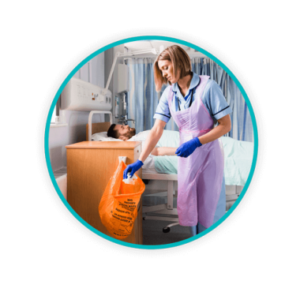 At the Point of Disposal: Clinical Staff
At the Point of Disposal: Clinical Staff
Doctors, nurses, and other healthcare professionals are often the initiators of the clinical waste journey. These are high-pressure roles and often fast-paced and time-sensitive, centred around patient care, which can make waste decisions feel secondary – often, the closest bin seems to be the ‘right’ one.
But the risks are real, and that’s why it’s crucial to use the right type of bin for the waste.
Some of the consequences of incorrect disposal at the point of care include:
- Needlestick injuries, which carry a risk of exposure to bloodborne pathogens and potentially fatal diseases.
- Cross-contamination, which carries a risk of spreading infection throughout and even outside of the facility.
- Waste overtreatment, which increases both treatment costs and environmental impact.
These outcomes rarely stem from a case of outright neglect. It’s usually down to one of a number of common challenges faced by clinical staff, such as resource constraints, a lack of awareness or inadequate training, or even poorly placed bins and unclear labelling.
When your waste systems are designed to support clinical realities, safer behaviour follows naturally.

Within the Facility: Domestic and Portering Teams
These frontline teams keep healthcare environments clean and operational. They handle waste in public areas, patient rooms, sluice areas, and loading docks, often with limited visibility into how items are disposed of.
Improperly sealed bags, overfilled sharps containers, or incorrectly disposed of clinical waste create risks such as:
- Cross-contamination and spill hazards during movement.
- Manual handling injuries from incorrectly sized or loaded bins.
- Exposure to sharps or hazardous liquids due to improper segregation.
Improving bin design, container placement, and consistent staff-wide training can make a significant difference, not just in safety, but in morale and efficiency.
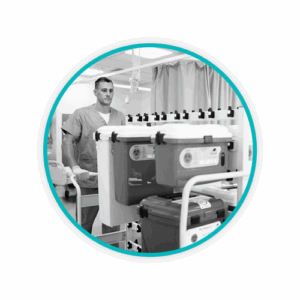 In Transit: Waste Handlers & Contractors
In Transit: Waste Handlers & Contractors
Whether transferring waste across departments or off-site, these individuals rely on the integrity of upstream disposal. When containers are mislabelled, split, or filled with the wrong materials, they are at risk.
Common issues include:
- Needlestick injuries from incorrectly discarded sharps.
- Leakage or exposure from non-secured infectious waste.
- Logistical challenges caused by miscategorised bags.
Segregation behaviours at the point of disposal directly influence the safety of transport, both inside the facility and via external collection teams. It’s a shared responsibility, and one where small changes upstream can have a significant protective effect, or cause considerable risk and potential harm downstream.
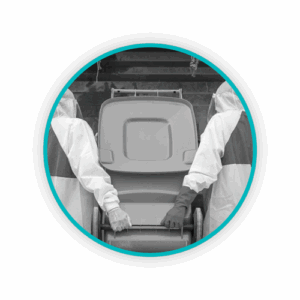
At the Treatment Site: Waste Processing Teams
At the final stage, waste treatment workers depend on correct categorisation. Mistakes made early in the journey can lead to:
- Injuries from sharps or chemicals where protective protocols weren’t triggered due to mislabelling.
- Contamination of automated processing lines, adding cost and risk.
- Inappropriate treatment, such as incinerating non-hazardous material, which increases environmental harm. Or, allowing dangerous chemicals and infectious items to survive the treatment process, and deemed ‘safe’.
These are often unseen consequences for those working inside hospitals, but they’re essential to address through system-level thinking and keep everyone protected throughout the entire waste journey.
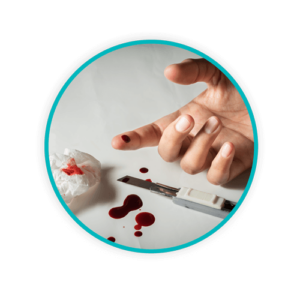 The Overfilled Sharps Container Scenario
The Overfilled Sharps Container Scenario
Let’s take a well-known and documented scenario to drive home the point a little more – overfilled sharps containers…
An overfilled sharps container can be more dangerous than having none at all, as the contents pose a direct risk to staff, patients, and visitors. Staff are often duped into a false sense of security, believing there is sufficient capacity to dispose of more sharps waste into it.
Say, for example, a doctor is coming to the end of a long shift and, after a clinical procedure, disposes of a sharp object into the correct container, but that container has now reached its ‘fill line’. The doctor either doesn’t pay attention to the fill level or does but decides there’s still some room for more, or leaves it to the next person to close down. Now, the next person to use that sharps container for disposal is put at risk, as is the domestic who needs to move it to a waste disposal area, as is the porter who needs to pick it up from there and move it downstairs to the waste compound. After this point, there’s still a driver who needs to interact with the overfilled sharps container, and the plant staff once it arrives for treatment and final disposal.
The point is, safety doesn’t end with the person disposing of the waste in the first instance – there are plenty more touchpoints down the line.
So the question to ask yourself with every disposal is: ‘Once I dispose of this waste, who’s affected by it if I haven’t disposed of it correctly? Who gets hurt?’
On the subject of sharps containers, it’s crucial always to follow the correct procedures and ensure they’re never overfilled, always locked, and labelled once they’ve reached their fill levels. Additionally, the lids must be properly closed.
But sharps waste was just one scenario. It’s critical to bear in mind that no matter what type of healthcare waste you’re disposing of, you won’t be the last person to interact with it.
How Does Improper Waste Disposal Affect the Environment?
Improper segregation of clinical waste or other medical waste streams from the point of origin has the potential to trigger a domino effect on the environment, resulting in contamination of land, water, and air, with downstream effects for humans, animals, and ecosystems.
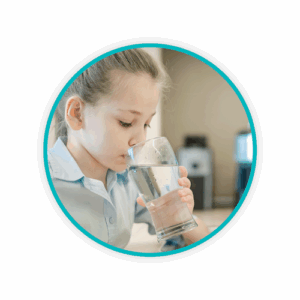 Some of the key risks include:
Some of the key risks include:
- Soil and water contamination: Incorrectly disposed of clinical waste can leach harmful substances into groundwater or surface water, affecting drinking supplies and aquatic life.
- Air pollution: Inappropriate incineration or open dumping of waste can release harmful chemicals, including dioxins, furans, and radioactive particles, which pose long-term public health risks.
- Threats to wildlife and domestic animals: Improperly stored or uncontained waste may attract birds, rodents, or stray animals. Exposure to infectious or chemical waste can harm these animals and contribute to the wider spread of disease.
- Public health risks: Waste that finds its way into unauthorised or unsecured areas may expose members of the public to sharps, pathogens, and infectious materials, especially in or near landfill sites.
Environmental hazards aren’t limited to large-scale spills or extreme neglect. Everyday missteps in disposal (such as placing infectious items in the wrong bin or failing to label containers properly) can trigger a chain of contamination that affects both people and the planet.
Sustainable waste management in healthcare begins with correct segregation at the source, and it requires awareness and commitment from every person at every step of the waste journey.
The negative impact of clinical waste on the environment should be a concern for every employee in every healthcare facility, regardless of its size or location.
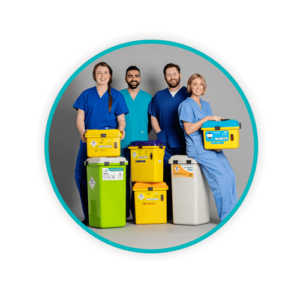
Sharpsmart Provides Empowerment Through Systems and Support
Every touchpoint in the clinical waste journey matters. From the doctor at the bedside to the porter, the transport team, and the waste processor – safety depends on the system as well as the individual.
The good news? Safer outcomes are within reach. Sharpsmart supports healthcare providers with:
- Consultative clinical waste audits to identify where things go wrong — and why.
- Staff-wide education that supports behaviour change without blame.
- Reusable, safety-engineered containers that prevent overfilling and reduce handling risks.
- Integrated reporting and benchmarking, so teams can see and celebrate progress.
Our goal isn’t to point fingers. It’s to make the right thing easier for every person in the waste journey, empowering all to make healthcare safer.
By creating an environment where education, engineering, and accountability work in tandem, healthcare providers can achieve meaningful improvements that protect staff, minimise environmental impact, and support uninterrupted care.
Contact us today to learn more about our clinical waste services and how we can help you create a safer and more compliant waste management system for your facility.
Let's Talk!
Your time is valuable, and we don’t want to play hard to get. You can either phone us directly on the details listed on our contact page, or feel free to fill out this short form and one of our team members will get back to you as quickly as possible.
